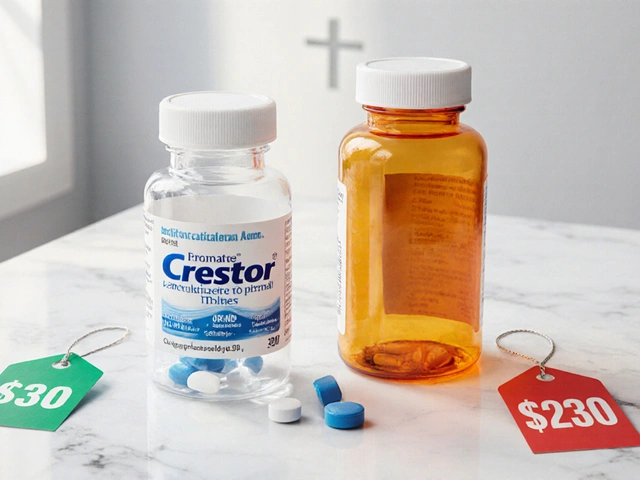Urinary leaks, urgency that hits out of nowhere, getting up three times a night-if you’re on bicalutamide, you might be dealing with some or all of that. Here’s the straight truth: the drug itself isn’t the only player. Your prostate, the cancer, other meds, your fluid habits, and your pelvic floor all matter. You can’t fix everything overnight, but you can get control. This guide shows what’s causing the symptoms, what you can do this week, and the exact red flags that need fast medical help.
- TL;DR: Track what’s happening for 3-7 days; that data guides the fix.
- Match the symptom to the type (urge, stress, overflow, nocturia). Each one has a different playbook.
- Start with bladder training, pelvic floor work, and smart fluid timing. Layer meds or devices if needed.
- Call your team fast for fever, blood clots in urine, or inability to pee. Those are not “wait and see.”
- Most men find a workable plan within 2-6 weeks when they combine habits, exercises, and the right medication.
What you likely want to get done right now:
- Figure out whether bicalutamide is the culprit or the cancer/BPH is doing most of the damage.
- Stop the leaks and bathroom sprints-today-while you’re waiting for clinic appointments.
- Decide if you need a med (and which one) versus pads, a clamp, or pelvic floor therapy.
- Know what’s urgent (ER-level) and what can wait for a message to your urologist/oncologist.
- Build a simple, daily routine that actually works when you’re at work, at the gym, or on a road trip.
Understand What’s Causing the Urinary Problems
Bicalutamide blocks androgens. It’s used for prostate cancer, often with other androgen deprivation therapy (ADT). The twist: lower androgens can change prostate tissue and bladder signaling, but urinary symptoms also come from the prostate itself (benign enlargement or tumor), prior surgery, radiation, infections, or diuretics. Sorting this out is the first win.
Here’s how to think about symptoms:
- Urgency and urge incontinence: a sudden, strong need to pee followed by leaking if you can’t reach a bathroom in time. Often bladder overactivity.
- Stress incontinence: leaks with cough, sneeze, lifting, or golf swings. Usually a pelvic floor issue; more common after prostate surgery, but it can happen without it.
- Weak stream, hesitancy, or dribbling: outflow obstruction from prostate enlargement or urethral narrowing.
- Nocturia: waking to urinate at night. Can be bladder overactivity, evening fluids, sleep apnea, or leg swelling shifting fluid at night.
- Retention: the bladder won’t empty. Pain, fullness, and small “overflow” leaks. Needs fast assessment.
Quick self-checks you can do this week:
- Three-day bladder diary: record time, volume in/out, leaks, triggers (caffeine, cold, long drives). This is gold when you speak with your clinician.
- Timed voiding test: set a 2-3 hour schedule. If urgency crashes through that schedule, you likely have an overactive bladder component.
- Cough test at home: a light cough with a mostly full bladder. If you leak, stress incontinence is part of it.
Red flag symptoms that should trigger same-day care:
- Inability to urinate for 6-8 hours with pain or swelling in the lower belly.
- Fever and burning urine (possible UTI) or flank pain (possible kidney issue).
- Visible blood with clots or steady bleeding in urine.
- New severe back pain, leg weakness, or numbness-rare but could signal spinal cord compression in advanced disease.
What the evidence says: FDA labeling for bicalutamide notes urinary tract symptoms occur, but many men’s symptoms come from BPH, cancer burden, or radiation history rather than the drug alone. The American Urological Association’s guidance on lower urinary tract symptoms (2023) and the International Continence Society definitions support the type-specific approach here. NCCN Prostate Cancer Guidelines (2025) emphasize early management of LUTS to keep therapy on track.
| Symptom pattern | Likely driver | Do-now steps | When to call |
|---|---|---|---|
| Sudden urgency + leaks | Overactive bladder after ADT, bladder irritation (caffeine), past radiation | Bladder training q2-3h, cut caffeine 2 weeks, consider mirabegron/antimuscarinic | Urgency with fever or burning (possible UTI) |
| Leaks with cough/sneeze | Pelvic floor weakness | Daily pelvic floor exercises, consider PT referral, use pads/guards short-term | Sudden severe worsening after procedure |
| Weak stream, straining | Prostate obstruction (BPH or tumor) | Alpha-blocker trial, avoid decongestants, hydration pacing, message your clinician | Retention, pain, or kidney function changes |
| Nighttime urination | Evening fluids, sleep apnea, bladder overactivity | Front-load fluids, elevate legs late afternoon, bedtime void, med adjust | New severe leg swelling or shortness of breath |
| Inability to pee | Acute retention | Urgent assessment; may need catheter | Immediate-go now |

What to Do: A Step-by-Step Plan That Actually Works
Before you add more prescriptions, lock down the basics for two weeks. These moves are low risk and often cut leaks by half.
-
Set up your fluid plan.
- Target about 1.5-2 liters total fluid per day unless your clinician told you otherwise.
- Front-load: drink most of it before 3 p.m. Keep evening sips small. Stop 2 hours before bed.
- Cut bladder irritants for 14 days: coffee, tea, cola, energy drinks, alcohol, very spicy foods, citrus. Reintroduce one at a time to test your threshold.
-
Use a bladder diary and a timer.
- Void on schedule every 2-3 hours while awake. No heroics. Don’t “hold it” too long.
- If urgency hits early, do 6 slow belly breaths, contract pelvic floor (see below), then walk-not run-to the bathroom. This retrains the reflex.
-
Do pelvic floor exercises the right way.
- Find the muscle: imagine stopping gas, not cutting off urine midstream (don’t practice during urination).
- Program: 3 sets/day of 10 slow squeezes (hold 5 seconds, release 5), plus 10 quick squeezes. That’s 60 squeezes per day.
- Breathe. Don’t clench abs, thighs, or glutes. Quality beats brute force.
- If you’re unsure, ask for pelvic floor physical therapy. Men benefit-especially after prostate procedures.
-
Protect your skin and dignity while you fix the root cause.
- Men’s guards or briefs with a hydrogel core trap odor and moisture. Change when damp.
- Use a barrier cream (zinc oxide or dimethicone) for irritated skin.
- For predictable leaks during activity, a gentle penile clamp can help for short windows (no more than 1-2 hours at a time; release every 30-60 minutes). Skip if neuropathy or fragile skin.
-
Bring meds into the mix if symptoms persist after two weeks-or sooner if they’re severe.
- Overactive bladder (urgency/leaks): beta-3 agonist (mirabegron or vibegron) or an antimuscarinic (oxybutynin, tolterodine, solifenacin). Mirabegron/vibegron avoid dry mouth/constipation but can nudge blood pressure; monitor if you’re hypertensive.
- Obstruction (weak stream, hesitancy): alpha-blocker (tamsulosin, silodosin, alfuzosin) relaxes the prostate/urethra within days. Watch for dizziness; take at night at first.
- Large prostate with long-term obstruction risk: a 5-alpha-reductase inhibitor (finasteride/dutasteride) can shrink the gland over months. Sexual side effects possible.
- Drug interactions: bicalutamide can raise warfarin effect; alpha-blockers plus blood pressure meds increase fall risk. Bring all meds/supps to your clinician.
Decision hints:
- If cough/sneeze leaks dominate: double down on pelvic floor work and activity planning; meds may not help much.
- If sudden urgency dominates and you already cut caffeine: try mirabegron or vibegron first if you’re older or prone to dry mouth/constipation; antimuscarinics are fine if you tolerate them.
- If weak stream or straining is the main issue: start an alpha-blocker, then reassess in 1-2 weeks. If no change, get a post-void residual check.
| Medication class | Typical examples | When it helps | Watch-outs |
|---|---|---|---|
| Beta-3 agonists | Mirabegron, Vibegron | Urgency/urge incontinence, nocturia | Can raise blood pressure slightly; check BP after 1-2 weeks |
| Antimuscarinics | Oxybutynin, Tolterodine, Solifenacin | Urgency/urge incontinence | Dry mouth, constipation, cognitive effects in some older adults |
| Alpha-blockers | Tamsulosin, Silodosin, Alfuzosin | Weak stream, hesitancy, incomplete emptying | Dizziness, low blood pressure; take at night initially |
| 5-alpha-reductase inhibitors | Finasteride, Dutasteride | Large prostate, long-term obstruction risk | Takes months to work; sexual side effects |
Devices and procedures if meds fall short:
- External (condom) catheter: useful for nighttime or heavy leaks without inserting into the urethra. Watch skin care.
- Intermittent catheterization: if you don’t empty well. Teaches you to drain fully without a permanent tube.
- Indwelling or suprapubic catheter: rescue option for severe obstruction or during radiation; plan skin care and infection prevention.
- For stress incontinence after prostate surgery: pelvic floor rehab first; if persistent, discuss slings or artificial urinary sphincter with your urologist (per AUA recommendations).
What to expect time-wise:
- Habits and pelvic floor work: early wins in 2 weeks; best results in 6-12 weeks.
- Alpha-blockers: sometimes within days.
- Beta-3/antimuscarinics: 1-4 weeks for clear improvement.
- 5-alpha-reductase inhibitors: 3-6 months for meaningful change.

Special Situations, Real-Life Troubleshooting, and FAQs
Nighttime issues (nocturia) are uniquely annoying. Here’s a plan that respects sleep and heart health:
- Front-load fluids and limit the last big glass to before dinner. Take only small sips after.
- Elevate legs for 30-60 minutes late afternoon if you have ankle swelling; it shifts fluid earlier so you pee before bed, not at 2 a.m.
- Empty right at bedtime. If you wake twice or more, ask about a short-acting med at night or checking for sleep apnea, which is underdiagnosed in men with nocturia.
If you use a catheter, prevention is your friend:
- Hand hygiene every time.
- Keep the bag below bladder level, tubing unkinked, and avoid breaks in the system.
- If urine turns cloudy with fever, or you have new pain, call the clinic. Don’t start antibiotics on your own.
If you’re balancing cancer care and work or travel:
- Pre-map bathrooms on long drives. Keep a urinal bottle in the car for emergencies.
- Use a guard or brief on flight days; choose an aisle seat. Hydrate, but time it.
- If a big meeting triggers urgency, do 5 pelvic floor squeezes before you stand up.
Radiation history changes the playbook a bit.
- Radiation cystitis can cause urgency, frequency, and blood. Keep the bladder diary and message your oncologist if visible blood occurs.
- Antimuscarinics or beta-3s are often helpful. For bleeding, clinicians may add bladder-specific treatments after evaluation.
Medication practical tips:
- Antimuscarinic dry mouth is real. Chew sugar-free gum, and add fiber for constipation.
- Mirabegron or vibegron are friendlier on mouth and bowels but check blood pressure two weeks after starting.
- Tamsulosin is kind to blood pressure but can still make you woozy the first few doses; take at night.
- If you take warfarin, tell your team-bicalutamide can raise INR. Any new med should be checked against your list.
Mini-FAQ
- Does bicalutamide cause incontinence? It can contribute indirectly by changing bladder signaling and fluid balance in the setting of ADT, but many men’s leaks come from pelvic floor weakness or prostate obstruction. That’s why matching symptom type to treatment works best. Source: FDA labeling; AUA/LUTS guidance.
- Will this get better if I stop coffee? Often yes-caffeine is a strong bladder irritant. Try two weeks off. Reintroduce slowly to test your limits.
- Can I take tamsulosin with bicalutamide? Commonly, yes. They act on different targets. Watch for dizziness, especially if you’re on blood pressure meds.
- Mirabegron and blood pressure-how worried should I be? Most see a small bump or none, but if you run high, check at home and share numbers after two weeks. Source: US prescribing information.
- Are pads covered by insurance? Sometimes, with documentation of incontinence. Ask your clinic for a letter of medical necessity or check your plan’s DME policy.
- How do I know if I’m emptying my bladder? Your clinic can check a post-void residual with a quick ultrasound. If it’s high, urgency meds alone may worsen retention-so test before piling on meds.
- What about alcohol? It can trigger urgency and night trips. If you drink, stick to one, and avoid it close to bedtime.
- Will pelvic floor therapy help even if I haven’t had prostate surgery? Yes. Men respond, especially when stress leaks are part of the story. Expect a 6-12 week program.
When to contact your team versus the ER:
- Message your team: new or worsening leaks not improving after two weeks of the plan; dizziness on alpha-blockers; urgency not controlled by first med.
- Same-day/urgent care: burning urine with fever; visible blood with clots; painful inability to pee for 6-8 hours; new severe back pain plus leg weakness.
Daily checklist (print or screenshot):
- Log fluids and bathroom trips (morning to night).
- Pelvic floor: 3 sets of slow squeezes + 10 quick squeezes.
- Timed voiding every 2-3 hours.
- Caffeine/alcohol plan for the day.
- Medication taken? Any side effects?
- Skin protection if using pads or devices.
What your clinician might order:
- Urinalysis and culture if infection is suspected.
- Post-void residual measurement to see if you’re emptying.
- PSA and imaging depending on cancer status, especially if symptoms change quickly.
- Referral to pelvic floor physical therapy or urology if conservative steps stall.
Why this approach works: it lines up with how urologists and oncologists think-identify the subtype, remove irritants, strengthen the pelvic floor, and add targeted meds. This tightens control without piling on side effects. The AUA, EAU, and NCCN documents from the last few years align with this layered plan.
Next steps / Troubleshooting
- If you’re just starting bicalutamide: begin the fluid plan and pelvic floor routine now. Book a check-in in 3-4 weeks to review your bladder diary and decide on meds if you still have problems.
- If you already have heavy leaks: add a beta-3 agonist or antimuscarinic now and keep the diary. Expect clear progress in 2-4 weeks; if not, reassess for incomplete emptying.
- If you’ve got weak stream or strain: ask for an alpha-blocker and a post-void residual check. If your residual is high, talk about intermittent catheterization until the obstruction is managed.
- If nights are the worst part: front-load fluids, elevate legs late afternoon, empty at bedtime, and discuss a nighttime medication trial.
- If you have a history of radiation: rule out UTI and bleeding sources first, then add urgency meds and bladder training. Keep your team in the loop about any visible blood.
- If you’re a caregiver: help with the diary, meds timing, and skin care. Watch for red flags and bring a list of questions to appointments.
Bottom line: you don’t have to white-knuckle your way through urinary symptoms. Track, target, and layer treatments. Most men find a stable routine in a few weeks-and keep their cancer therapy on schedule while staying active at work, in the gym, and out in the world.




John Dumproff
August 30, 2025 AT 18:22I was terrified the first time I leaked during a Zoom call. Thought I was the only one. But after 3 weeks of timed voiding and cutting caffeine, I’m back to running 5Ks without pads. Pelvic floor stuff felt weird at first-like trying to flex a muscle I didn’t know I had-but now it’s just part of my morning routine. You don’t need to fix everything overnight. Just show up, track it, and trust the process. It gets better.
Also, if you’re on bicalutamide and think it’s the drug’s fault? Maybe, but often it’s the combo of ADT + BPH + bladder irritation. The symptom breakdown in the post? Gold. I wish I’d read this before I started.
And yes, I still use guards on long drives. No shame. Survival mode is real.
Keep going. You’ve got this.
Lugene Blair
August 31, 2025 AT 05:14Bro, I did the bladder diary for 5 days and realized I was drinking 3 liters of water a day because I thought ‘hydration = good.’ Turns out, I was just filling a leaky bucket. Cut it to 1.8L, front-loaded it, and stopped drinking after 5 p.m. Nocturia dropped from 4x to once. Changed my life.
Also, mirabegron was a game-changer. Dry mouth? Yeah. But I chewed gum and didn’t die. My urologist said ‘you’re doing better than 80% of men on ADT.’ That’s not luck. That’s discipline.
Stop waiting for a miracle. Start with the checklist. Do it for 14 days. Then come back and thank yourself.
shridhar shanbhag
August 31, 2025 AT 22:10From India, where urology care is still a luxury for many. I’ve seen men suffer silently because they think this is ‘just aging.’ But this guide? It’s clear, practical, and doesn’t assume you have a specialist down the street. The bladder diary idea? Brilliant. Even in villages, men can write down times and triggers on a phone or paper.
Alpha-blockers are often unaffordable here, but pelvic floor exercises? Free. Zero cost. Just 60 squeezes a day. That’s something anyone can do. Thank you for writing this with real people in mind-not just American insurance patients.
Yaseen Muhammad
September 1, 2025 AT 04:24While the general advice in this post is sound, there are several inaccuracies in the clinical context that require correction. Bicalutamide, as a nonsteroidal antiandrogen, does not directly cause urinary retention or overactive bladder; rather, it exacerbates preexisting lower urinary tract symptoms (LUTS) secondary to androgen deprivation-induced prostate tissue remodeling. The AUA guidelines (2023) explicitly classify these as ‘ADT-induced LUTS,’ distinct from BPH or radiation cystitis, though overlap is common.
Additionally, the recommendation to use pelvic floor exercises without prior assessment of post-void residual volume is potentially hazardous. In men with significant obstruction, anticholinergics or beta-3 agonists can worsen retention, leading to acute urinary retention-a true urological emergency. Always confirm bladder emptying before initiating these agents.
Finally, the phrase ‘most men find a workable plan in 2–6 weeks’ is misleading. While symptom control may improve, true physiological adaptation often requires 3–6 months. Setting unrealistic expectations leads to nonadherence. Precision matters.
Dylan Kane
September 1, 2025 AT 19:29Wow. So you just wrote a 3,000-word self-help guide and called it ‘medical advice’? Congrats. You’re basically a TikTok urologist now.
Let me guess-you’ve never actually treated a patient with metastatic prostate cancer, right? All this ‘bladder diary’ and ‘pelvic floor squeezes’ sounds nice, but if you’re on bicalutamide and your PSA is climbing, your bladder issues are the least of your worries. This feels like a wellness blog masquerading as clinical guidance.
Also, ‘front-load fluids’? That’s not a medical strategy, that’s a lifestyle influencer’s idea of ‘optimization.’
Just say you’re selling a PDF and move on.
William Cuthbertson
September 2, 2025 AT 07:22There’s a quiet, almost spiritual dimension to managing urinary symptoms on ADT that rarely gets spoken about. It’s not just about muscles or meds-it’s about reclaiming agency over a body that feels increasingly alien. The act of tracking your voids isn’t just data collection; it’s a ritual of reconnection. Each time you pause, breathe, and choose to walk to the bathroom instead of letting urgency dictate your life-you’re not just managing a symptom. You’re rewriting your relationship with vulnerability.
And in a world that tells men to be stoic, to never show weakness, this quiet discipline-this daily commitment to care for the parts of you that feel broken-is perhaps the most radical act of masculinity there is.
I’ve seen men cry when they realize they can finally sleep through the night again. Not because of a drug. But because they finally trusted themselves enough to try. That’s the real win here. Not the chart. Not the medication. The courage to begin.
Eben Neppie
September 3, 2025 AT 04:49Yaseen’s comment is technically correct, but it’s missing the forest for the trees. Most men reading this aren’t urologists. They’re dads, coaches, truck drivers-people who need to know how to stop leaking during a game of golf, not the pharmacokinetics of bicalutamide. The post’s strength is its actionability.
That said, the ‘pelvic floor exercises’ section is dangerously vague. Saying ‘imagine stopping gas’ is not enough. You need to specify: squeeze the muscle between scrotum and anus, hold 5 seconds, release fully, no glute engagement. And for god’s sake, warn people not to do Kegels mid-urination-that can cause bladder neck damage.
Also, mirabegron’s BP effect is understated. In hypertensives on beta-blockers, it can cause tachycardia. Add a warning. And no one should use a penile clamp without a urologist’s approval. Seen too many guys with necrotic glans because they ‘thought it’d help.’
This guide is 90% perfect. Fix the 10% that could cause harm, and it’s textbook material.